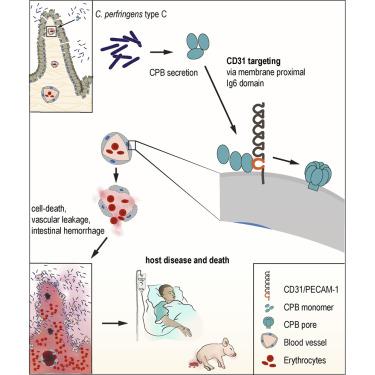Cell Host & Microbe ( IF 20.6 ) Pub Date : 2020-06-03 , DOI: 10.1016/j.chom.2020.05.003 Julia Bruggisser 1 , Basma Tarek 1 , Marianne Wyder 1 , Philipp Müller 2 , Christoph von Ballmoos 2 , Guillaume Witz 3 , Gaby Enzmann 4 , Urban Deutsch 4 , Britta Engelhardt 4 , Horst Posthaus 5

|
Clostridium perfringens β-toxin (CPB) is a highly active β-pore-forming toxin (β-PFT) and the essential virulence factor for fatal, necro-hemorrhagic enteritis in animals and humans. The molecular mechanisms involved in CPB’s action on its target, the endothelium of small intestinal vessels, are poorly understood. Here, we identify platelet endothelial cell adhesion molecule-1 (CD31 or PECAM-1) as the specific membrane receptor for CPB on endothelial cells. CD31 expression corresponds with the cell-type specificity of CPB, and it is essential for toxicity in cultured cells and mice. Ectopic CD31 expression renders resistant cells and liposomes susceptible to CPB-induced membrane damage. Moreover, the extracellular Ig6 domain of mouse, human, and porcine CD31 is essential for the interaction with CPB. Hence, our results explain the cell-type specificity of CPB in vitro and in the natural disease caused by C. perfringens type C.
中文翻译:

CD31(PECAM-1)用作产气荚膜梭菌β-毒素的内皮细胞特异性受体。
产气荚膜梭菌β毒素(CPB)是一种高活性的形成β孔的毒素(β-PFT),是动物和人类致命性坏死性出血性肠炎的必需毒力因子。对CPB对其靶标(小肠血管内皮)的作用的分子机制了解甚少。在这里,我们确定血小板内皮细胞粘附分子1(CD31或PECAM-1)作为CPB在内皮细胞上的特异性膜受体。CD31表达与CPB的细胞类型特异性相对应,并且对于培养的细胞和小鼠中的毒性至关重要。异位CD31表达使耐药细胞和脂质体易受CPB诱导的膜损伤。此外,小鼠,人和猪CD31的细胞外Ig6结构域对于与CPB相互作用至关重要。因此,我们的结果解释了CPB的细胞类型特异性C型产气荚膜梭菌引起的体外和自然疾病











































 京公网安备 11010802027423号
京公网安备 11010802027423号